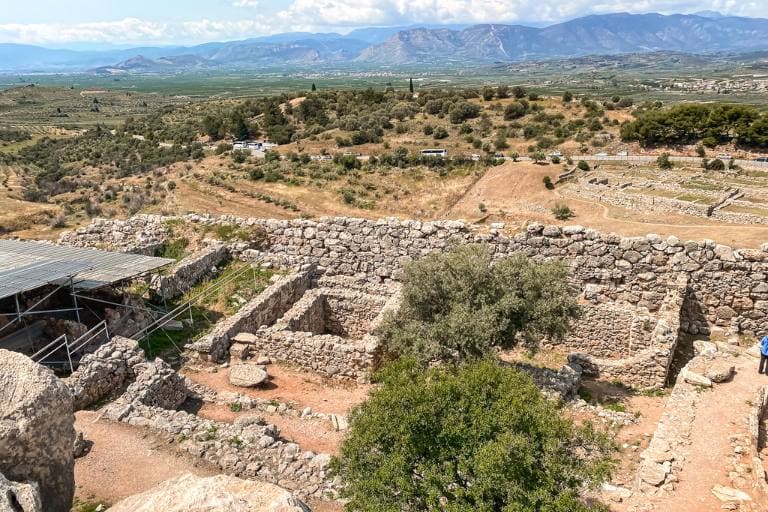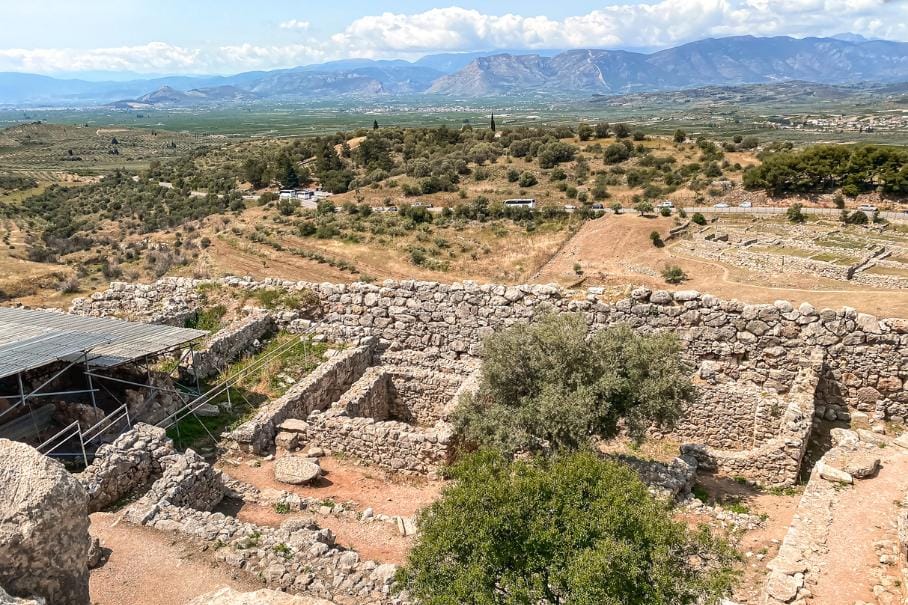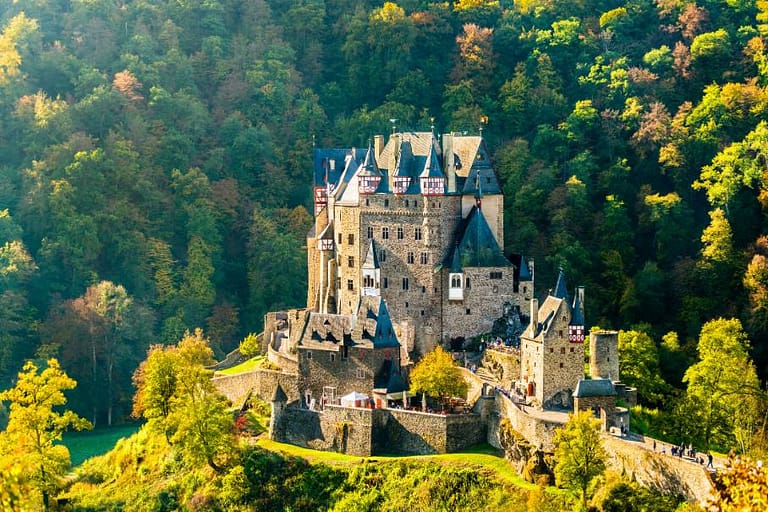Mycenae Greece: An Epic Journey into Myth and History
PRESS TRIP – There is something about myths and legends that can add a unique allure to any destination. For me, visiting Greece, especially the Peloponnese region, was like stepping into a fascinating world of Greek mythology. It’s a land of gods and heroes you can almost believe is real. This was especially palpable when I went to the archeological site of Mycenae Greece.
The Mycenae Archaeological Site sits in the rugged landscapes of the Peloponnese Peninsula. The views are spectacular and probably haven’t changed much over the millennium. You can almost feel the whispers of the past and the echoes of the greatness of the warriors who lived here.
Whether you believe in the myths or not, the site is a fascinating place to explore. Here, you can learn about the legendary Mycenaean civilization that influenced classical Greek culture and inspired the writer Homer. Here is what you need to know before you visit.
Affiliate Disclosure – This post contains affiliate links. If you make a purchase through these links, I may earn a commission. This doesn’t affect your purchases or any fees you may pay for the product or service. Read more in my DISCLAIMER.
Overview of the Mycenaean Civilization
The Mycenaean civilization flourished from around 1,600 to 1,100 BC. The Mycenaeans developed a rich and distinct culture during their centuries of rule. They were renowned for their unique art, often featuring stylized animal designs and exquisite pottery.
They also had a complex language system known as Linear B tablets – though the meaning of it remains largely unknown to this day. It is speculated that Linear B served as the predecessor of ancient Greek, though this is still debated among scholars.

The society was also quite advanced regarding its government and military practices. It had a hierarchical system of ruling families responsible for leading their people into battle and enforcing laws throughout the kingdom.
The Mycenaeans were incredibly skilled at trading and developed networks of merchants throughout the Mediterranean. Many scholars attribute this level of sophistication to their success as a culture.
The legacy of Mycenaean culture has been long-lasting, with many aspects still influencing Greek society today. From its art and mythology to its language and government structures, the influence of Mycenae remains evident in modern Greece.
Mycenae in Greek Mythology
According to Greek mythology, Mycenae was founded by Perseus, the legendary hero who slayed the Gorgon Medusa and rescued Andromeda. If you believe the story, it later became the home of King Agamemnon, who led the Greeks during the Trojan War. Agamemnon is said to have led his troops on a ten-year siege of Troy following the kidnapping of his sister-in-law, Helen (of the face-that-launched-a-thousand-ships fame) by the Trojan prince Paris.
King Agamemnon was a bloodthirsty fellow with a yen for power. He wasn’t shy about eliminating those who stood in his way. He even sacrificed his daughter Iphigenia to the gods so that he could go and fight in the war. After his return from Troy, he was killed by his wife Clytemenestra and her lover (I mean, can you blame her?).

While Homer’s epic poems are considered fiction, it’s widely thought that the Mycenaean civilization, home to a thriving upper class of kings and rulers, directly inspired the writer. These works were likely based on events during the Mycenaean era, with some literary licence thrown in by Homer for dramatic effect.
Wandering through the ancient ruins of Mycenae, I couldn’t help but connect the dots between the myths and the reality before me. The imposing Lion Gate, the mysterious Grave Circles, and the bustling Lower Town all seem to echo the stories of heroes, kings and gods from Greek mythology. As someone who studied history and had to read Homer’s The Illiad and The Odyssey, this was a bucket list experience for me.
Excavations of Mycenae
German archaeologist Heinrich Schliemann first excavated the site of Mycenae in 1874. Much like his quest for the city of Troy, he believed that Homer’s poems were based on reality and set about finding them.
The first excavations of the site produced crucial archaeological evidence of Mycenae and its rich cultural heritage. Previously, initial excavations were done. the archaeological society before Schliemann arrived on the scene. Schliemann uncovered a treasury of precious metals including gold, silver and bronze artifacts dating back to the Mycenaean period.

He also uncovered a spectacularly large grave that he believed belonged to Agamemnon, leader of the Greek forces in Troy. Interpreting Homer’s poems as the real deal.
The archaeological excavations at Mycenae uncovered many important artifacts from the Mycenaean period. These include pottery, weapons, art objects, carved gems, figurines and other items. The findings of this excavation are now housed at the National Archaeological Museum in Athens and offer valuable insight into the Mycenaen culture and how it influenced European cultures.
Archaeological Site of Mycenae Greece
The site is more extensive than I anticipated, which is even more impressive considering its age. I’m not an expert on archaeological sites, but even I could tell that all the walls, especially the outer city walls, were built differently from how the Romans built them. I was very impressed with myself for being able to differentiate ancient ruins.
The Mycenaeans built their cities with massive limestone boulders. These stones, often of different shapes and sizes, were roughly fitted together without mortar. You can also see the square door and window frames, which are also hallmarks of what is known as cyclopean masonry.

Walking around the site was a fascinating experience. I couldn’t help but feel awe and admiration for the people who built it. I always wonder what they would think of what’s left of their grandeur today. Would they be dismayed that their civilization was reduced to ruins, or would they be amazed that so much of it is still here? I would guess probably a little bit of both.
What to see at the Mycenea archaeological sites
While there isn’t too much left from the ancient Mycenae, you can still imagine how powerful it must have been in the ancient Mediterranean world. If it was a small, inconsequential settlement, there wouldn’t be anything left of it today. So, what can you experience here? Let’s take a look.
Lion Gate
The most iconic feature at Mycenae is the Lions Gate. This monumental entrance to the city was part of the Citadel’s fortified walls. It features two large lions carved in relief and is the only surviving structure from the Bronze Age era.

In its heyday, the Lions Gate would have been guarded by massive double doors. Although the original door is long gone, the two lion sculptures remain and are a fitting tribute to this powerful civilization.
Mycenaean Citadel
Another significant feature of Mycenae is the Citadel, located at the city’s highest point. This impressive fortress served as a safe haven for Mycenaens during wars. It was well-defended with its double walls and underground tunnels.

The entrance to this Citadel is guarded by a sturdy gate, which could be closed off to keep out unwanted visitors. Inside the Citadel, archaeologists have discovered remains of the residences of Mycenaean nobility and a massive great central hall likely used by the ruling king and his family.
Grave Circle A
This area contains the tombs of some of Mycenae’s most powerful leaders. These burial sites for Mycenaean royalty were built between 1600 and 1500 B.C. The graves were decorated with impressive stonework and grave gifts such as vases, weapons and jewelry.

Grave Circle B
This area contains the shaft graves of more common citizens, although some of these tombs are still quite elaborate. It is believed that this area was used for family burials and may have also had a religious significance.
Mycenae Lower Town
This area features buildings stretching down the hill from the citadel. This is where the majority of Mycenae’s population lived, worked and traded. It was home to merchants, sailors, artisans, craftsmen, farmers and other ordinary people. Even though much of it has been destroyed or overgrown with vegetation, it is still possible to make out the remains of a few buildings.
Mycenae Archaeological Museum
Situated within the walls of the Mycenae site, the archaeological museum houses a large collection of artifacts found at the archaeological site. These include pottery, weapons, jewelry, and frescoes which help to illustrate the wealth and power of the Mycenaean civilization. The museum is definitely worth a visit and provides a good overview of what life was like in Mycenae during its heyday.
Treasury of Atreus
The famous treasury of Atreus, also known as the Tomb of Agamemnon, is an impressive beehive-shaped tomb, also known as tholos, and is one of the most iconic features of Mycenae. Built with a corbelled roof, it stands 13 meters tall and is believed to have been used as a royal tomb for the powerful kings of Mycenae. It was constructed around 1,250 BC and is a reminder of the power and wealth that the Mycenaeans held in their empire.
Tips for exploring the archaeological sites of Mycenae Greece
Visiting the Mycenae Archaeological Site is a must-see experience for anyone who wants to know more about Greece’s history. If exploring legendary locations speaks to you, then you’ll love this place. Here are a few tips to help you make the most of your visit:
- Wear comfortable shoes and dress in layers.
- Bring a hat and sunscreen if you visit in hotter weather, as there is not a lot of shade.
- Bring plenty of water and snacks.
- Start your visit early in the morning to avoid crowds, especially during the school season, as many kids come here on school trips.
- Take a guided tour to get the most out of your experience.
- Be sure to check for any special events that may be taking place during your visit, as these can offer a unique look at the history of Mycenae.
- Don’t forget to explore beyond the archaeological site. There are plenty of other attractions in and around Mycenae that are worth exploring.
How to get to Mycenae
Mycenae is located in the Peloponnese region of Greece. To get there, you can take a bus or drive from Athens, or take a train and then a local bus from Corinth. You can also fly into Kalamata Airport, about an hour and a half away by car. There is a parking area where you can leave your car while you explore.
Visit this site for detailed site info and admission details.

Where to Stay in Mycenae
Mycenae is a great day trip from Athens, but I recommend staying nearby to get a better feel for the area. Nearby towns such as Tiryns, Argos, and Nafplio all offer accommodation from budget hostels to luxury hotels, so you can choose one that fits your budget and needs.
Conclusion
Mycenae is an incredibly fascinating archaeological site that offers a unique insight into the culture and history of this region of Greece. With its stunning ruins, beautiful scenery and incredible atmosphere, it’s an unforgettable experience. So, if you’re looking for a place to explore and learn about Ancient Greek history, visit Mycenae on your next trip to Greece.
At Mycenae, you can explore some of the most important archaeological remains in the country. Plus, you can walk in the footsteps of mythical figures, warriors and gods – the coolest part of the experience, in my opinion.

NOTE: I visited Nafplio as part of a press trip that was hosted by the Mythical Peloponnese in collaboration with Tbex. As always, all opinions are my own.
FAQ
What is Mycenae Greece famous for?
Mycenae is famous for being an important archaeological site in Greece that dates back to the Bronze Age, with the first evidence of settlements dating to 2,100 BC. It is most known for its role in developing Ancient Greek civilization and a significant location in Homer’s epic poem about the Trojan War.
Is Mycenae Greece worth seeing?
Yes, the site of Mycenae is definitely worth seeing. Its historical significance and ties to fascinating mythology make it a truly unique experience. Here you can explore the ruins of this ancient city, fortification walls and shaft graves as you imagine the historic times that predate the Greek language.
How far is Mycenae from Athens?
Mycenae is about 115 km southwest of Athens and can be reached in a little over an hour by car. It’s also easily accessible via public transportation. You can take a bus from Terminal A at Kifissos Bus Station, Bus 051 from Omonoia Bus Station or the X93 from the airport of Athens.
What destroyed Mycenae?
Mycenae was destroyed by a combination of events, including natural disasters and the invasion of the Dorians into the region. Eventually, the city was abandoned.
Travel Resources
Planning your next trip? Check out the resources I use and start planning your perfect getaway today!
- Flights: Find the best flight deals on Kiwi.com (my new go-to for flights)
- Book your accommodations: Find the best prices on hotels with Booking.com
- What to do: Find the perfect tour with Viator
- Need a car? Book your ride with Rentalcars.com
Check out my travel resource guide for more resources to help you plan your trip.









